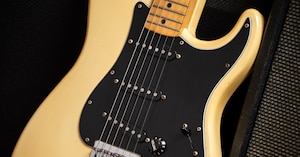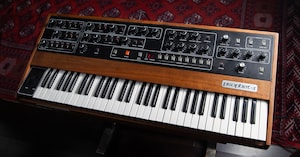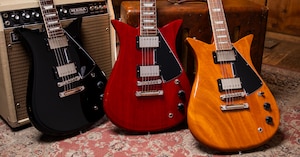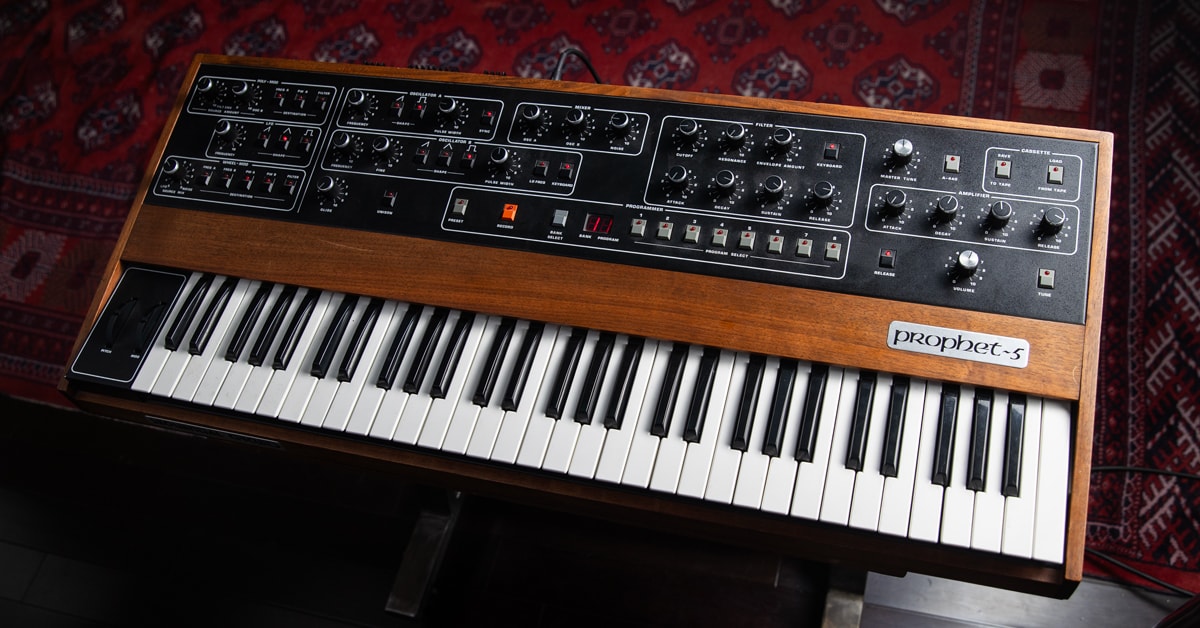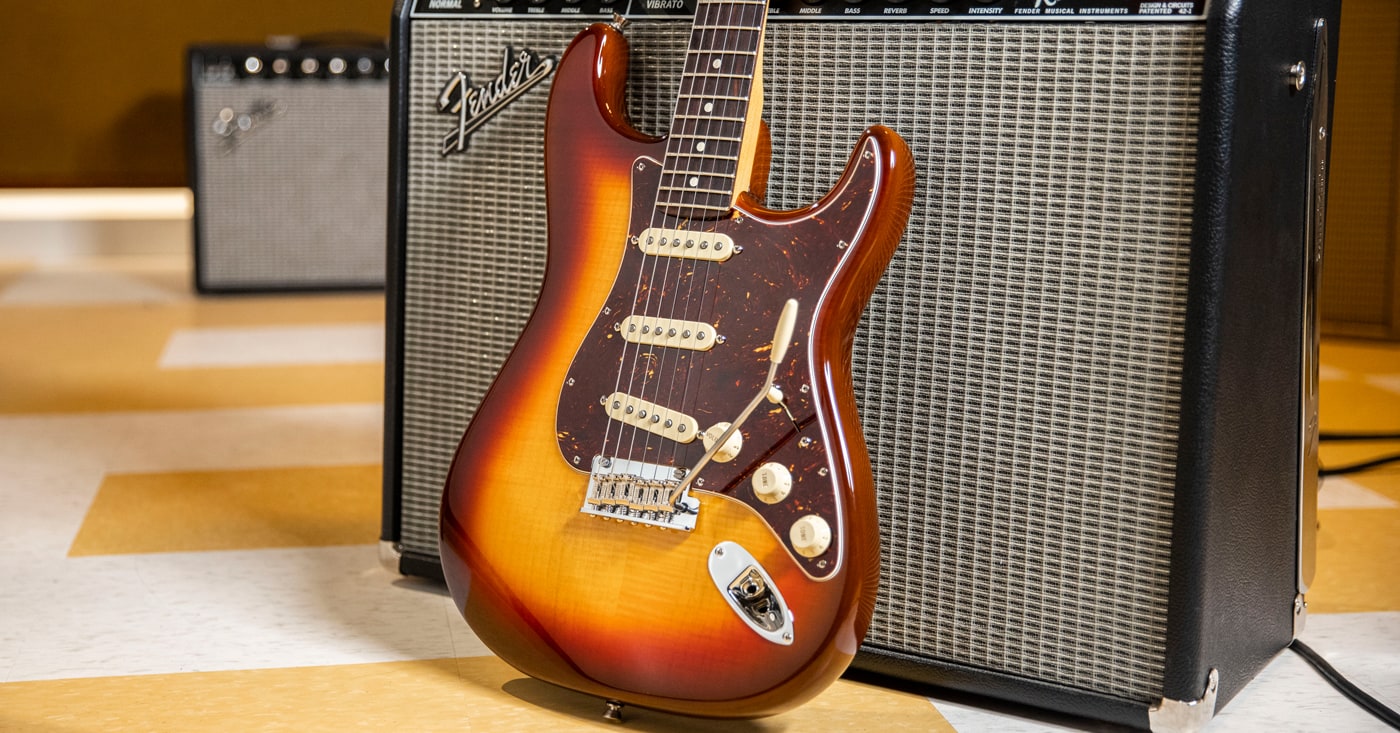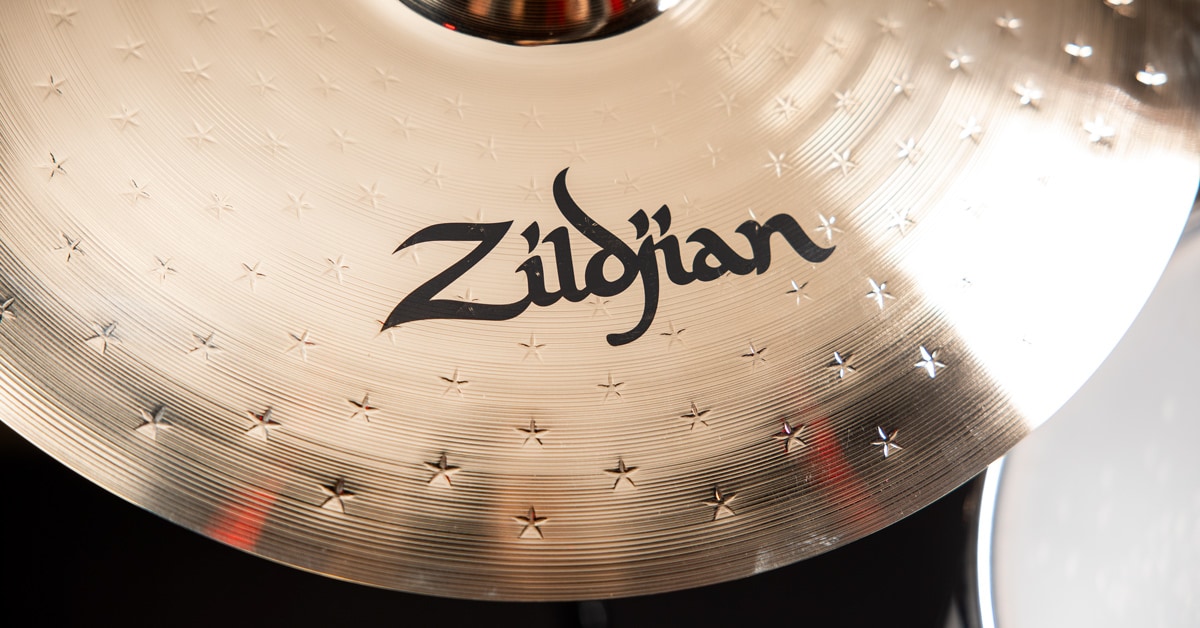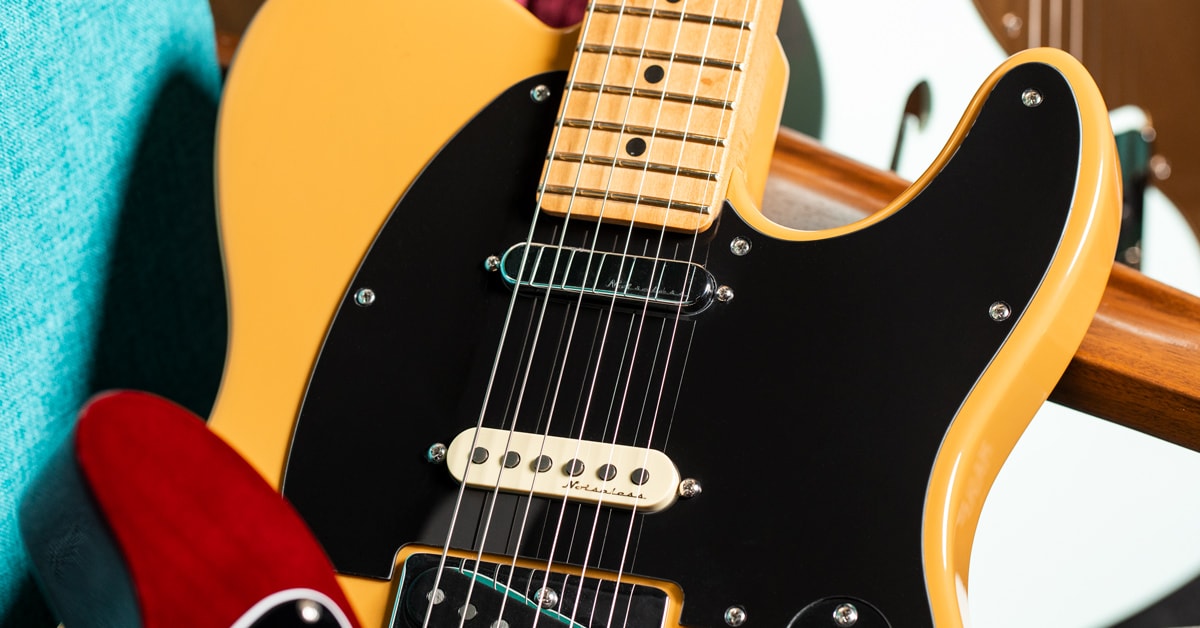The Fender Telecaster is the essence of what an electric guitar is, stripped down to only the essentials—wood, strings, pickups and basic controls. Going by the philosophical principle known as Occam's Razor, which states that the simplest explanation for anything is the one that is most likely to be true, we're reasonably sure that if William of Occam were around today, he'd be playing a Fender Telecaster. Sometimes, simple wins.
Table of Contents
The Sound of a Tele
A Brief History of Early Telecaster Guitars
The Birth of the Telecaster
How the Telecaster Evolved
A Buyer's Guide to the Modern Telecaster
Vintage-Style Telecasters
Squier Classic Vibe Telecaster
Fender JV Modified Telecasters
Fender Vintera Telecasters
Fender American Vintage II Telecasters
Contemporary Telecaster Models
Squier Sonic Series Telecasters
Squier Affinity Telecasters
Squier Contemporary Telecasters
Fender Player Telecasters
Fender Player Series Saturday Night Special Telecaster
Fender American Performer Telecasters
Fender American Professional II Telecasters
Fender American Ultra Telecasters
Telecaster Artist Models
Christone "Kingfish" Ingram Fender Telecaster Deluxe
Brent Mason Fender Telecaster
Jason Isbell Fender Telecaster
J Mascis Fender Telecaster
Jim Root Fender Telecaster
Chrissie Hynde Fender Telecaster
Jimmy Page Fender Telecasters
Raphael Saadiq Fender Telecaster
The Fender Custom Shop Telecaster
Everybody Needs a Tele
Legends of the Telecaster
The Sound of a Telecaster
Beyond just its simplicity, the Telecaster changed the way electric guitars sounded. Leo Fender's various design and engineering decisions came together to create a guitar with a voice that spoke in a way many guitarists hadn't realized they needed. The combination of a solidbody with a pickup featuring separate magnets for each string and a combined pickup/bridge assembly created a sound with a unique snap and twang that cut through like no "Spanish-style" electric guitar had yet been able to, and at volumes that enabled the guitar to be competitive on a raucous honky-tonk stage. Of special interest here is the bridge and pickup assembly. By using a conductive bottom plate on the bridge pickup and then mounting it in a steel plate, not only is the pickup effectively shielded, but the magnetic field also becomes more focused, which translates to a louder, clearer signal. For the first time, it was far easier for guitarists to step forward and be featured. And the list of featured players is a history of 20th and 21st-century popular music.
A Brief History of Early Telecaster Guitars
Leo Fender famously never played a guitar, or any other musical instrument, though he loved music. So, how did he come to create not one, not two or even three, but at least half a dozen (and we're not stopping to count, but it's more than that) of the most iconic electric guitars and basses on the face of the planet? Fender's journey from a radio repair shop in Fullerton to a world-spanning manufacturer is one of the greatest examples of how an enquiring mind, the ability to listen to the ideas of others and a serious work ethic can combine to change the world. Let's take a quick look at how the Telecaster came to be.
The Birth of the Telecaster
First things first, let's dispose of one piece of misinformation that's out there about the Telecaster. The date of the Tele's launch is frequently held to be 1948, though some have said 1946. This is largely because, under the ownership of CBS (and more about this a little later), the Fender marketing department had made those claims in various ads and press releases. In actual fact, the Esquire and Telecaster (then called the Broadcaster), which are essentially the same guitar with a difference in pickup arrangement, debuted at the NAMM show at the beginning of 1950. Part of the confusion may also be that, starting in 1946, Leo Fender filed several patents for various elements of what would become the Tele.
One other thing to mention. While both Les Paul and Paul Bigsby had previously built solidbody electric guitars, they were essentially handmade one-offs. Fender, following his philosophy that if something is easy to service, it's easy to build, was the one who created the first production solidbody electric guitar.
1946 was also the year Leo bought out Clayton "Doc" Kaufman, a musician and fellow tinkerer, with whom he had founded K&F Manufacturing in 1945 and founded the Fender Electric Instrument Company. Fender's 1946 patent on the string-thru-coil, or "horseshoe" magnetic pickup also shows the pickup on a solidbody instrument that, although it looked somewhat like a lap steel, had a rounded neck for playing "Spanish style." A second patent, this one for the bridge/pickup combination, was filed in 1948, showing it on a single-cutaway body that bears a striking resemblance to the guitars that were to come.
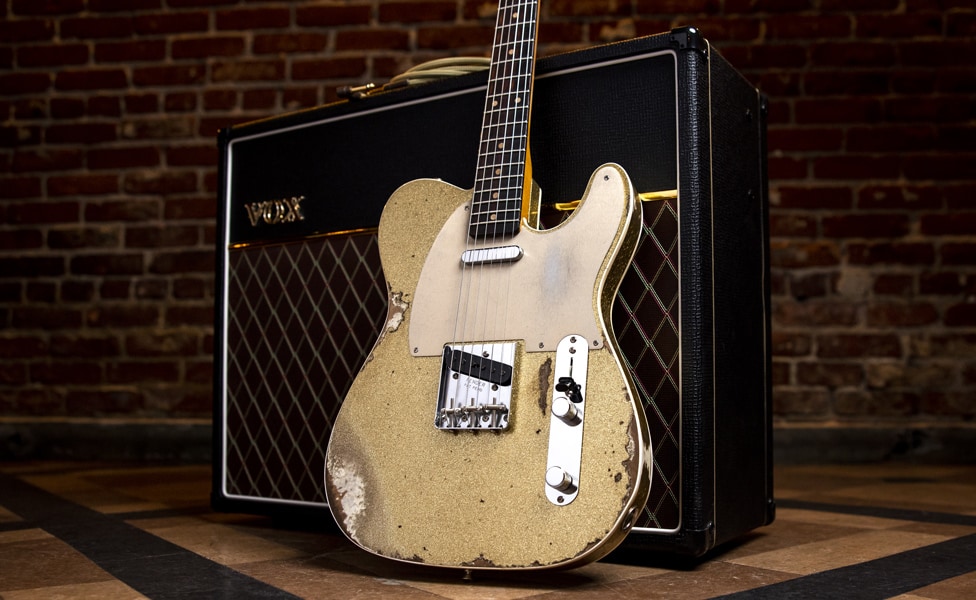
Fender's success with steel guitars and amplifiers, combined with his tendency to listen carefully to feedback from players, had led him to develop tight ties with the West Coast country and Western swing communities. And what he had been hearing from guitarists was that they wanted an instrument that wouldn't feedback easily and would cut through the sound of a sizable band in the same way that Fender's steel guitars did. With the patents filed, and the basic concepts pulled together, prototypes began to appear in 1949.
There are two other names we need to bring into the story here: George Fullerton and Don Randall. Fullerton, a machinist and electronics hobbyist with a flair for drawing, had joined the young company in 1948, and is credited with refining the body designs. Randall, who was working for Francis Hall (who would go on to purchase Rickenbacker Guitars) as a salesperson for Hall's distribution company, RTEC, had convinced Hall to distribute Fender's amplifiers and steel guitars. A natural sales and marketing type, Randall had become quite involved with Fender and was responsible for naming quite a few of Fender's early products. And, speaking of names …
The Name Game
When the instrument that would become the Fender Telecaster debuted at the 1950 NAMM show in Chicago, that name lay in the future. The guitar that was shown was the single-pickup Esquire, while the two-pickup model, which Don Randall had dubbed the Broadcaster, would debut later that year. But there was a problem.
When the Broadcaster debuted in late 1950, Fender shortly afterward received a communication from Fred Gretsch requesting that they cease using the name, as Gretsch had been making a drum set named "Broadkaster" since the 1920s. Fender quickly pulled the name and the ever-frugal Leo Fender simply clipped the "Broadcaster" from the supply of decals and continued using them with the Fender logo, but no model name. These guitars, which were produced for less than a year, have become known as the "Nocaster," though that has never been any sort of official name.
In the meantime, Don Randall, who had been thinking of radio and its importance to music when he named the guitar the Broadcaster, was looking at the booming growth of television that was then occurring, and decided that, in a similar vein to the first name of the guitar, a reference was called for, and proposed the name "Telecaster." So, in less than a year, we had one guitar with three names—rather two names and one not-name. But what were the differences, if any, between the first guitars and the later ones? For that, let's look at some (not-overly) technical specs.
How the Telecaster Evolved
The standard Telecaster, while remaining almost unchanged, visually, over the years, has, nonetheless, gone through a surprising number of small changes and branching out. Many of the changes have been "under the hood"—in some cases "under the fingerboard." We can divide up the Telecaster's evolution into three periods: Fender under Leo Fender's ownership (1946–1965), Fender under the ownership of CBS (1965–1984), and post-CBS (1984–today). Let's take a quick look at the changes during these three periods.
The Leo Years
One thing Leo Fender was known for was constantly seeking to improve and fix … well, everything, pretty much (there are stories of people coming to Fender's campus in Fullerton wanting to see "the boss," only to be taken out on the factory floor, where Leo would be busy working on one of the machines incorporating improvements he'd thought of). On the early Telecasters, most of those improvements were under the hood, with only a handful of cosmetic changes.
While some of the prototypes were built out of pine, Fender felt that it would have been too soft and easily dented for regular production, so the wood was switched to hard, but relatively lightweight swamp ash. It's worth noting that Fender never specifically called out anything beyond "a clear hardwood" in their ads, brochures and catalogs prior to several years into the CBS period. The grain of an ash body was also quite attractive under the semi-translucent "butterscotch blonde" finish of the early Telecaster. Starting in 1955, the standard finish became creamier and more opaque, and alder occasionally came into use as a body wood, as suitably light ash was getting more difficult to source.
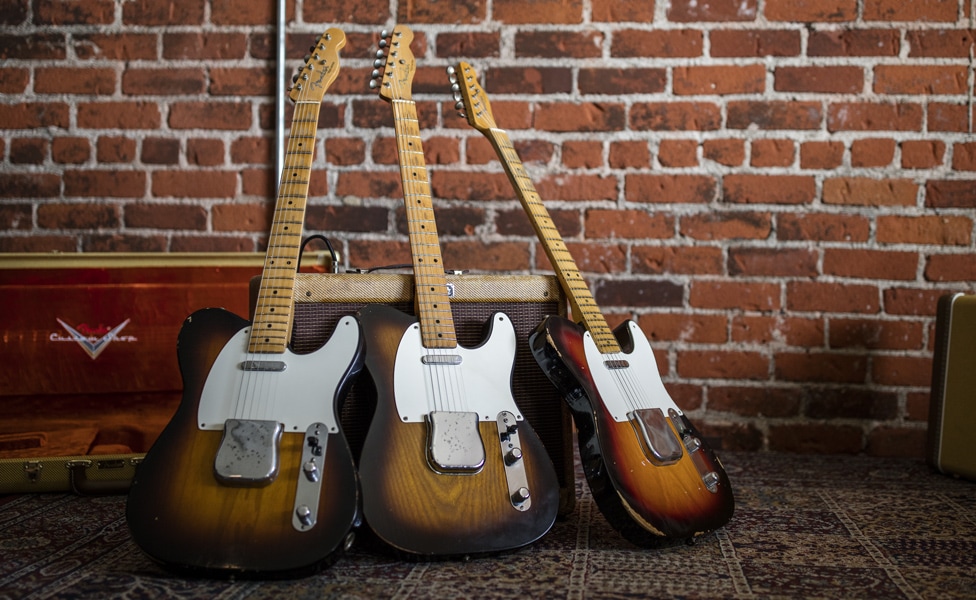
Some of the very earliest Esquire and Tele builds were made without a truss rod in the neck. Fender had felt that the hard maple the necks were built from would resist warping sufficiently to not need one, demonstrating the strength of the neck by laying one between two chairs and having an employee stand on it. But resistance from dealers and players, along with pressure from Don Randall, quickly changed his mind. Since the early necks were made of a single piece of maple, with no separate fingerboard, the truss rod was inserted from the back of the neck, resulting in the classic "skunk stripe." A handful of early guitars were made with a maple skunk stripe, rather than the contrasting mahogany that is more common.
The other big cosmetic change for the standard Tele was the switch from a black Bakelite pickguard to a single-layer, white plastic guard in 1954. A couple minor changes were the switch from stamping the serial number on the bridge plate to placing it on the neck plate, and a change from brass to steel bridge saddles. The neck profiles also changed, going from a pronounced "V" to a softer one, and from serious "baseball bat" thickness (a holdover from the original no-truss-rod neck) to one that was thinner and more comfortable for players. And rosewood fingerboards began to make an appearance toward the end of the '50s, becoming standard in 1959, though maple was still an option. But underneath the bridge and pickguard, there were other changes being made, and one that wasn't.
The original 1950 and '51 Telecaster had no actual tone control. Instead, that knob was a blend between the two pickups, and the front switch position had a capacitor that created a preset, bass-heavy sound that Fender referred to as a "soft rhythm sound." The middle switch position was the neck pickup only, with no tone control and the rear switch position was the bridge pickup with the ability to blend in the neck pickup in whatever amount the player desired. The Esquire, on the other hand, had a real tone control that worked in the middle switch position, while the rear position bypassed the knobs entirely, being wired directly to the output, much like the modern "blower" switch. In 1952, Fender changed the Tele's wiring, adding a tone control, but keeping the oddly conceived front switch wiring (which, to the best of our knowledge, nobody ever actually used). This meant there was no available neck+bridge switch position—the middle and rear switch positions were neck pickup with tone control and bridge pickup with tone control. Strangely, this wiring setup would last until 1967, when CBS changed it to the standard (and to us, logical) neck, neck plus bridge, bridge arrangement. It's rare, in fact, to find a pre-1967 Tele in totally original shape, as most players didn't take long to clip out the capacitor and rewire the switch. For the pickups themselves, Leo Fender switched from flat to staggered pole pieces for the Telecaster in 1955, matching the stagger on Stratocaster pickups that had debuted the previous year.
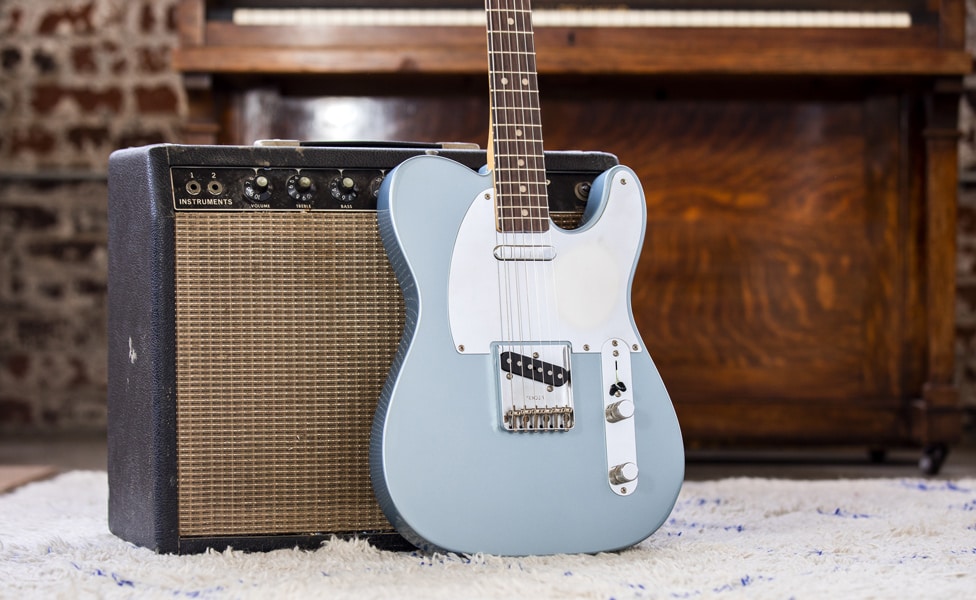
This wasn't all for the 1950s, though. In 1959 the Telecaster Custom made its debut. With either a top-bound or fully bound alder body with a new triple-ply pickguard, rosewood-topped fingerboard and three-color sunburst finish, these were Fender's flagship Tele (there was also an Esquire Custom, an exceptionally rare bird, indeed). These days, if you find a vintage Custom it will probably look like a two-tone sunburst instead of three, as the red dye that Fender used was extremely prone to fading from UV exposure.
Except for a very short run of mahogany Telecasters in 1963–65, that was pretty much it for changes in the Tele from the original company. But much bigger changes were to come after Leo Fender sold the company to Columbia Broadcast Systems (CBS) in 1965.
The Tele Under CBS
The CBS ownership of Fender Musical Instruments, as the company was now known, often gets a bad rap, and not without some reasons. The CBS push for higher-volume manufacturing did, on occasions, lead to a decrease in quality, or at least a change in quality, as with the shift from lacquer to polyester, then polyurethane finishes. But let's concentrate on the positives here because, despite some opinions to the contrary, some of the Telecaster innovations under the stewardship of CBS were advances and improvements, a number of which have stuck around until today.
For many players, the biggest change was the shift from Fender's somewhat unusual 1950s wiring to a more straightforward, neck, neck + bridge, bridge switch setup. But Fender had another trick coming with the help of Seth Lover, who had designed the original humbucking pickup for Gibson in the 1950s. The Fender Wide-Range Humbucker adopted Leo Fender's scheme of individual magnets as pole pieces, rather than use a single magnetic along the base of the pickup. In this case, the magnets were of CuNiFe, an alloy of copper, nickel and iron, which could be machined with threads so that the individual poles could each be adjusted separately. The Wide-Range has 12 of these, with six visibly adjustable and the other six hidden under the pickup cover. As you might expect from the name, it had a more "hi-fi" sound, with a substantially wider frequency bandwidth than previous humbuckers.
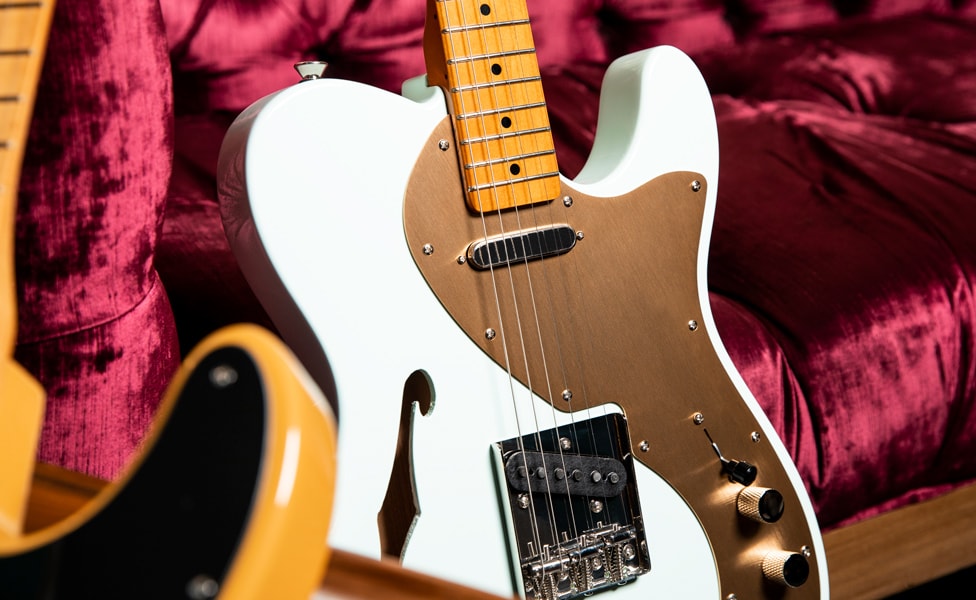
CBS introduced several new models, descendants of which have been with us ever since. First came the introduction of the Telecaster Thinline. Fender had been experimenting with ways to lighten the Tele body for some time, perhaps due to the difficulty in getting lighter-weight ash and alder. The first experiments were simply drilling a number of holes underneath the pickguard. A number of these, dubbed "Smuggler's Teles," were produced in late 1967, but the Thinline body we know today debuted, with standard Tele neck, wiring and pickups, and a modified pickguard, in 1968. Keeping with the concept of keeping instruments easy to manufacture, the Thinline had the body cavities routed from the rear with an f-hole cut in the upper bout, then a solid piece of wood glued to the back of the guitar. This resulted in a slightly more resonant body that maintained the feedback resistance of the fully solid Tele, with a look that was a little jazzier. The Thinline would evolve with the Type II Thinline swapping in Wide-Range humbuckers in 1971. The new pickups also were used in the Telecaster Deluxe and a single one as the neck pickup in a revised Telecaster Custom, the Custom Type II, which echoed what many working players had done in replacing their neck pickup with a humbucker.
From a strictly stylistic standpoint, the Pink Paisley and Blue Flower Telecaster iterations were a nod to "flower power," and were certainly marketed as such. It's interesting, though, that the player most associated with the paisley version was James Burton, hardly a flower child.
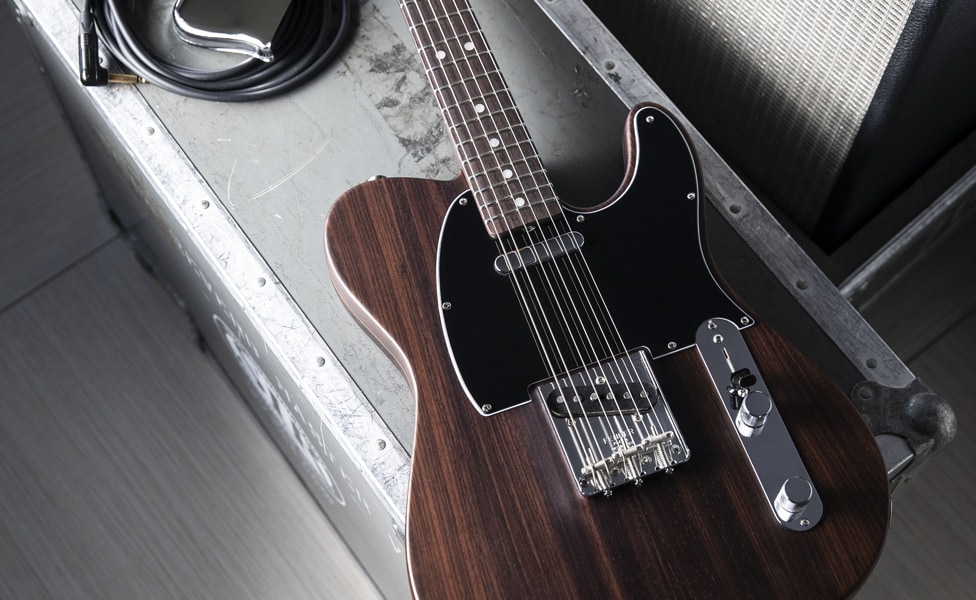
The Rosewood Tele is certainly worth a mention here. It was not originally intended as a regular model, and just three were made in 1968, with one famously presented to George Harrison, as thanks for the boost Fender sales had gotten from Harrison's featured use of a Strat in the Beatles' Magical Mystery Tour BBC television special. Harrison played the guitar during the recording of Let It Be and on the rooftop live performance associated with that album's release.
Aside from the fairly short-lived, active electronics Telecaster Elite, that's as far as new Telecaster models went under CBS' ownership, though there was one other business decision that has had an ongoing impact on Fender. Over the winter of 1981–82, Fender partnered with a pair of Japanese distributors—Kanda Shokai and Yamato Music—to form Fender Japan. These guitars would be built by Fuji Gen, and later by Dyna Gakki. They were originally intended for sale only domestically in Japan and for export to Europe, and Fender revived a brand they had owned since 1965, when they had purchased V.C. Squier, a string manufacturer. By 1983, though, it had become obvious to Fender that they needed to bring a lower-priced guitar to the U.S. market to be more competitive in their own domestic market. (If you’re interested in learning more about the history of Fender in Japan, check out our 2023 interview with Fender’s Allen Abbassi). This partnership would be the last major decision made by CBS at Fender. Things were about to change in a major way.
Modern Fender Is Born
By the middle of 1984, CBS had decided it wanted to get out of the guitar business and ended up selling the company (but not the Fullerton factory site) to "an investor group led by William Schulz, president of Fender Musical Instruments." That investor group comprised virtually the whole of the then-current Fender management team. Since the factory had not been included, it was extraordinarily lucky that Fender Japan would be there to fill the gap until new U.S. manufacturing could be set up. But enough business stuff. Back to the Telecaster.
The very first Telecaster model to be manufactured in the new U.S. facility would be a Vintage Telecaster reissue. These were produced in relatively small quantities, due in large part to the difficulty in sourcing sufficiently high-quality swamp ash (BTW, if you ever see a reference to "punk ash," it's the same thing—wood that's from lower down on an ash tree grown in a wet climate. No actual swamps, or punks, need to be involved).
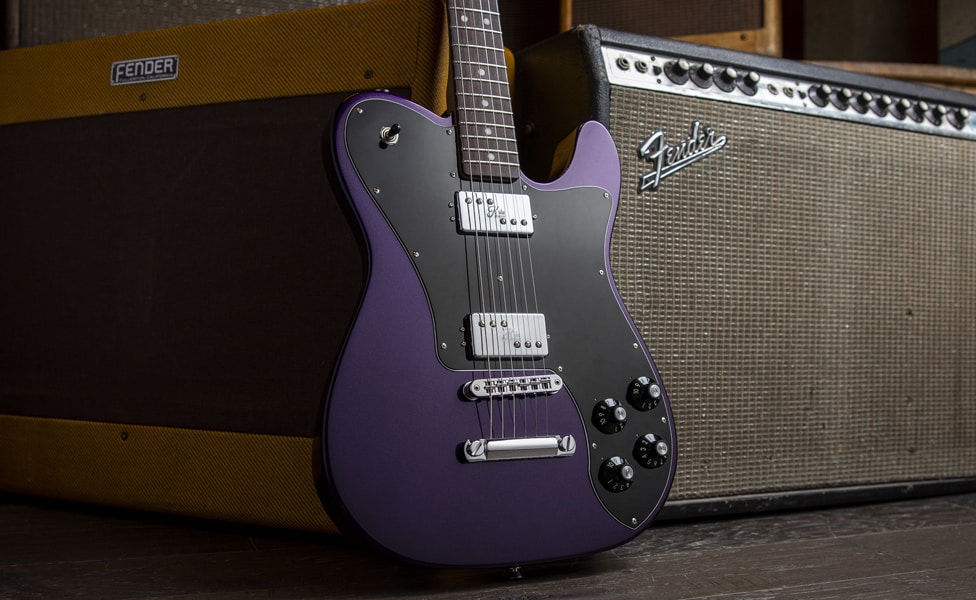
Following the vintage reissue was the American Standard Telecaster in 1987. The changes on this instrument were a flatter, 9.5" radius neck, 22 frets instead of the vintage-blessed 21, a revised 6-saddle bridge and, perhaps most noticeable to the ear, the bridge pickup no longer had the copper-plated tin plate underneath it. This created a more mid-range-rich tone that was tamer and less spiky (or ice-picky) than the vintage version. The alder-bodied instrument also carried one of Fender's TBX (Treble Bass eXpander) tone controls, a passive tone control that acts on both treble and bass frequencies. The history of the TBX is muddy, with some believing that it first appeared on the Eric Clapton Signature Stratocaster, but that was in 1988, and this was a year earlier. It's a similar circuit to the PTB (passive treble/bass) tone control that Leo Fender had developed for his new designs at G&L Guitars, so perhaps it was merely, consciously or not, a return to the source.
It was around this same time that the Fender Custom Design and Manufacturing (aka Fender Custom Shop) was founded, and one of the first Custom Shop projects was the, somewhat misnamed, 40th Anniversary Telecaster (because A: there was still some confusion about when the first Telecaster was made and B: it sounds a lot better than 38th Anniversary Telecaster). This limited run of 300 guitars featured an ash body with a book-matched flamed-maple top, curly maple neck with abalone inlays, gold-plated hardware and a pearloid pickguard, along with a commemorative certificate. The Custom Shop also began to build special runs, work with artists to design and build signature instruments and began to bring together a crew of master luthiers who could turn out some of the world's finest guitars. The mission of the signature instruments in particular was to create more than just an instrument that resembled an artist's favorite guitar, but to build either as exact a copy as possible of that guitar, or to create a new design, in partnership with the artist, that would be their "dream guitar."
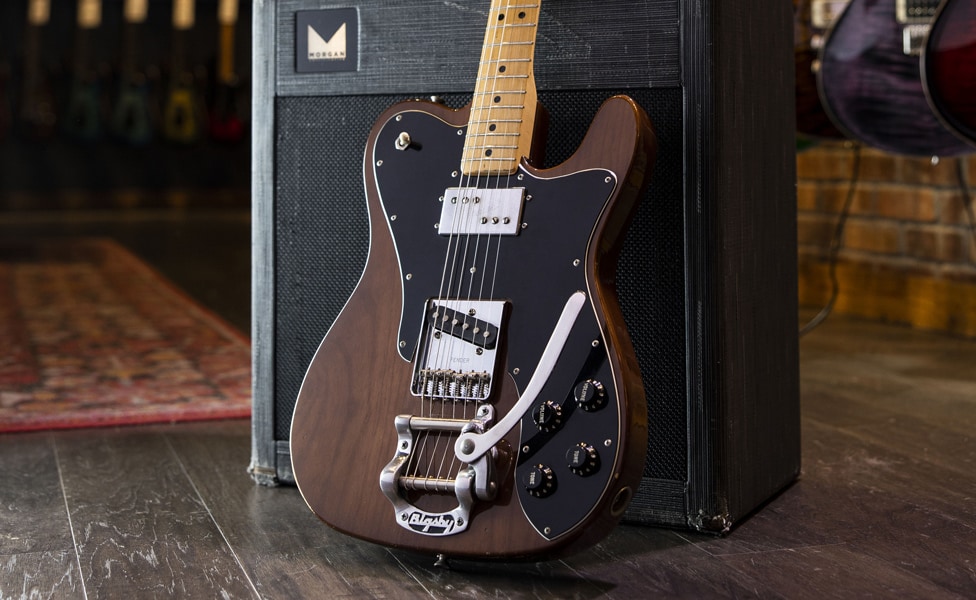
A prime example is one of the first signature Telecaster designs, built with Tele legend James Burton, and debuting in 1990. Featuring a new version of Red Paisley finish that had been Burton's signature since 1969, replacing the original lacquered-over paisley-patterned contact paper with a silkscreened design that wouldn't wear off, the guitar was created with substantial input from Burton. The 9.5" radius neck harkened back to the vintage days with its 21 frets and original-style truss rod, rather than the bi-flex rod Fender had switched to. The big change was Burton's choice of three of the then-new Lace Sensor pickups and a five-way switch. Among other early signature Telecaster models were a painstaking recreation of Albert Collins’s treasured '66 Tele Custom with a neck humbucker the artist had added, and a Danny Gatton signature model that featured custom Joe Barden humbucking pickups.
The Tele variations since 1990 have been numerous, but primarily small refinements on the stroke of genius that was Leo Fender's original design. How many other items designed more than 70 years ago are still in daily use, much less demand? Yet the Telecaster in all its stripped-down simplicity remains the tool of choice for so many different players across virtually every musical genre. The biggest question for any guitarist is, "Which Tele should I get?"
A Buyer's Guide to the Modern Telecaster
When it comes to the range of currently available Fender Telecaster models, you've got a lot of choice—from vintage-inspired models to contemporary takes on Fender's classic design. In the following sections, we're going to look at both those categories, and provide a little info on the most popular current Tele versions. Let's start with a look at some of the vintage models.
Vintage-Style Telecasters
Ahhh, the basic Tele—it set the template for all the solid body guitars to come when it rolled out in 1950. If you want simple, straight-into-the-amp, classic vibe and tone, here's the first place to look.
Squier Classic Vibe Telecaster
From original Butterscotch Blonde '50s and '60s Thinline, to '70s Custom, these Squier Classic Vibe Telecaster guitars are an enjoyably affordable way to get your feet wet or expand your existing Tele collection. With features and looks true to the originals, plus that great Telecaster tone and feel, the hardest choice is what decade is your favorite.
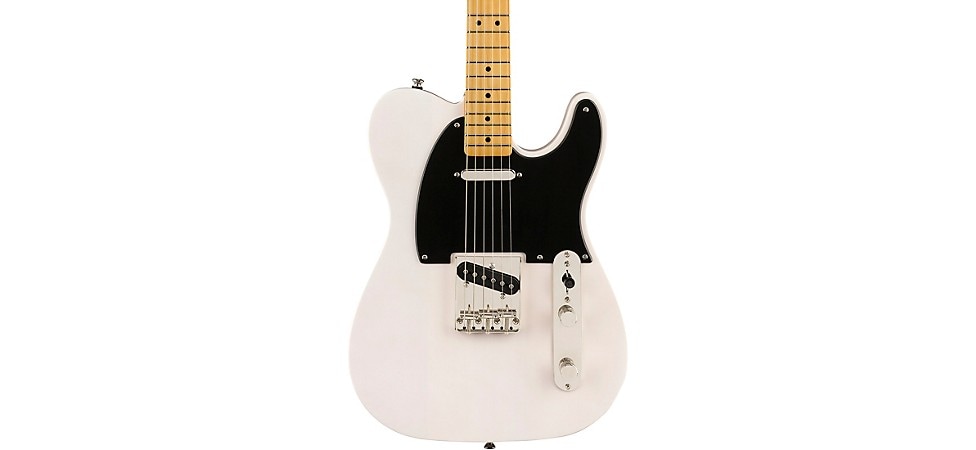
Pictured: Squier Classic Vibe '50s Telecaster
Fender JV Modified Telecaster
As we mentioned earlier in this article, after Fender joined forces with a pair of Japanese distributors in 1982, among the first guitars produced by this new partnership were recreations of vintage Fender models. These quickly gained a following for their stunning fit and finish, as well as their value. Fender's JV Modified series was created as a 40th Anniversary tribute to those guitars, intended to combine vintage inspiration with modern features.
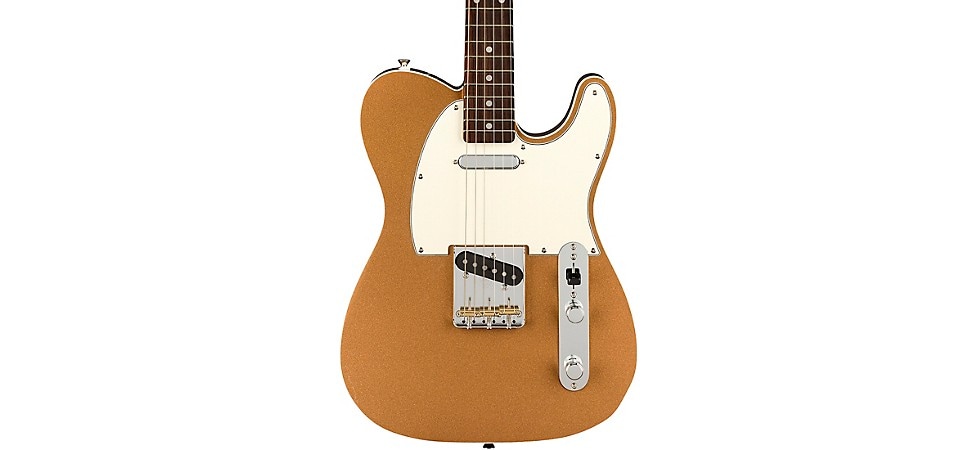
Pictured: Fender JV Modified '60s Custom Telecaster
The Fender JV Modified '50s Telecaster and the Fender JV Modified '60s Custom Telecaster sport those classic Tele look, but with some changes for the modern player. A slimmer, soft-V neck profile and flatter 9.5" fingerboard radius start it off. Both feature vintage-voiced pickups, but there's some extra magic happening in the electronics. Instead of the standard 3-way Tele switch, this is a 4-way, adding series pickup wiring (a popular Tele mod) in the front position for a little extra grunt. The push-pull tone pot puts the pickups out of phase in the combined pickup positions (two and four, or one and three, depending on how you number switch positions). The Fender JV Modified Telecaster models are a great choice if you're looking for a tightly built vintage-style Tele to add to your guitarsenal.
Fender Vintera Telecasters
The Fender Vintera Telecaster models span the Tele's first three decades—the Vintera '50s Telecaster, the '60s Tele Modified and a '70s Telecaster Deluxe. These Ensenada-built Telecasters deliver classic vintage features like brass barrel saddles, an early '50s U neck profile and 7.25" radius on the '50s Tele and re-voiced Wide-Range Humbuckers on the '70s Tele Deluxe. The '60s Modified Telecaster has player-friendly mods like hotter pickups, a modern neck profile, 4-way switching and Fender's S1 switch for added tonal versatility.
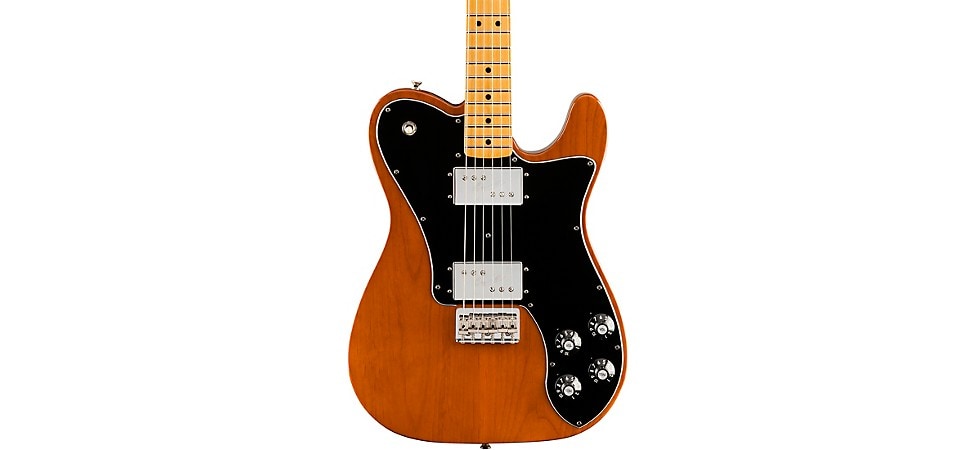
Pictured: Fender Vintera '70s Telecaster Deluxe
Fender American Vintage II Telecasters
The Fender American Vintage II series is built with period-accurate detail inspired by a specific vintage year, from the neck profile, fingerboard radius and slot-head screws on the 1951 model to the recreation of the original CuNiFe magnets on the 1972 Thinline's Wide-Range Humbucker. For non-Custom Shop guitars, these are probably as close as you can get to wandering into Guitar Center in 1951 (I know, we didn't exist yet, but play along here), 1963 or 1972. For a deeper dive into the creation of the Fender American Vintage II series, check out this interview with Fender Director of Product Management Allen Abbassi.
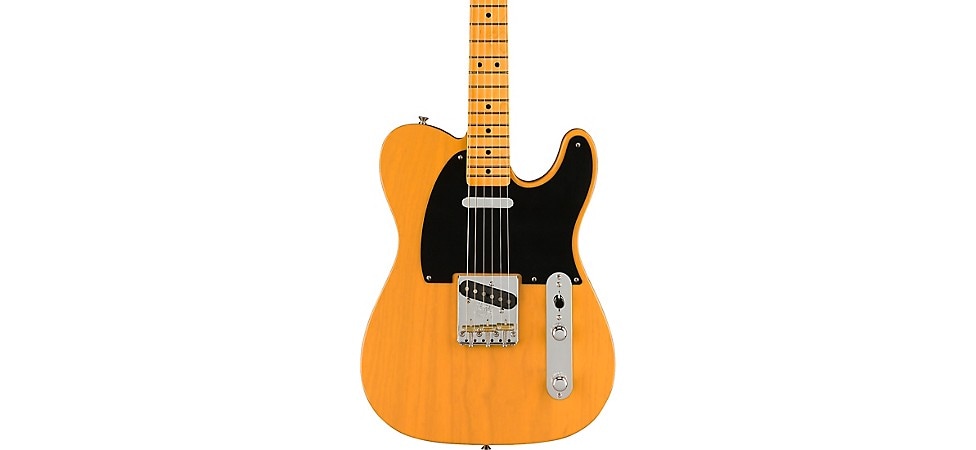
Pictured: Fender American Vintage II 1951 Telecaster
Contemporary Telecaster Models
If vintage vibes aren't your thing, and you're looking for something a little more up-to-date in a Squier or Fender Telecaster, then this selection of contemporary Teles is sure to have something that will make you and your fretting fingers happy.
Squier Sonic Series Telecaster
The most affordable Squier guitars to date, the Squier Sonic series includes a pair of Telecaster models, the Sonic Telecaster with maple fingerboard and the Sonic Telecaster with Indian laurel fingerboard. Both models boast a modern C-profile neck with a 9.5" radius fingerboard, 6-saddle bridge and lightweight poplar bodies. If you're looking for your first Tele and on a budget, these are a great place to start.
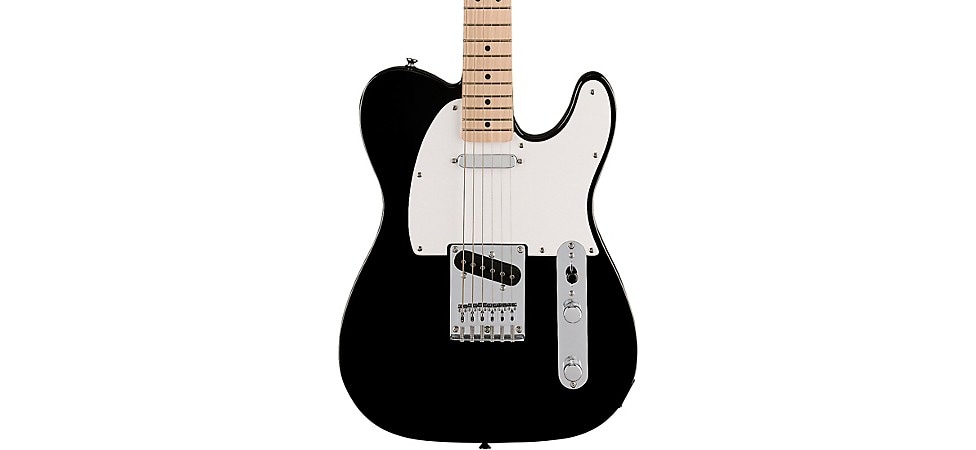
Pictured: Squier Sonic Telecaster
Squier Affinity Telecaster
The Squier by Fender Affinity Series Telecaster steps in as a kind of "beginner plus" instrument. This model adds upgrades to pickups, tuners and neck profile for a Tele that's a great place to start, and an affordable backup guitar if you're already playing and want to add a Tele to your collection.
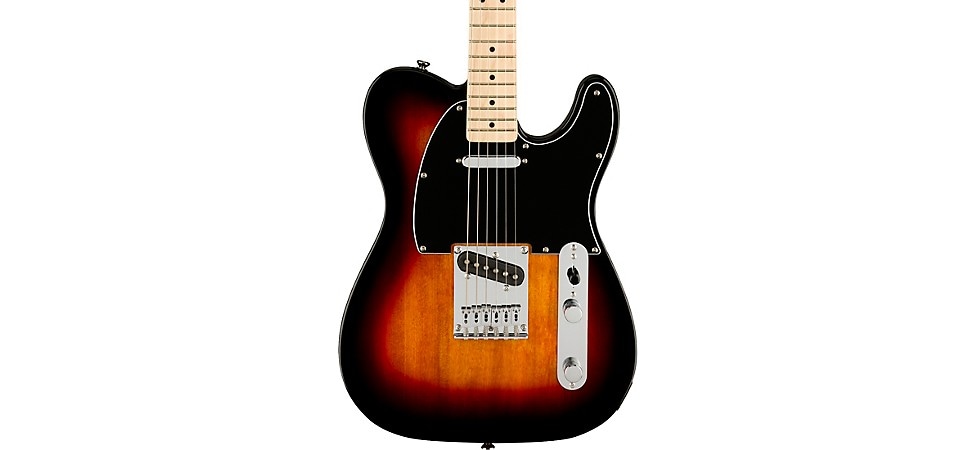
Pictured: Squier Affinity Series Telecaster
Squier Contemporary Telecaster
If you're Tele-curious, but your playing is more on the heavy side, meet the Squier Contemporary Telecaster. Loaded up with high-output humbuckers and boasting a roasted maple fingerboard, a modern neck joint for easier upper fret access and locking tuners, this Tele is ready to shred.
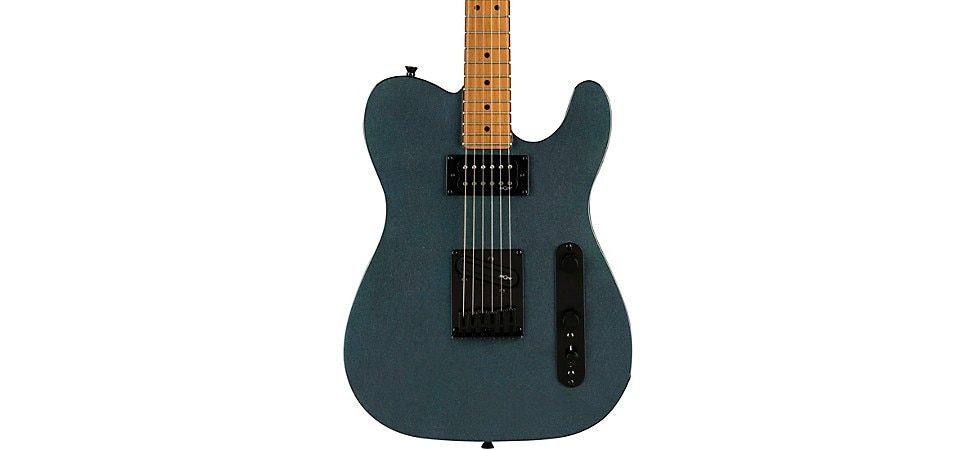
Pictured: Squier Contemporary Telecaster
Fender Player Telecaster
The Fender Player Series Telecaster provides excellent value in a gig-ready Tele. For this article, we're looking at both a pau ferro fingerboard in the single-coil version and the rockin' dual Alnico II humbuckers with a maple fingerboard. Both models feature a modern C profile, 22-fret, 9.5" radius neck and lightweight alder bodies. The single-coil flavor comes with steel block saddles, while the HH version makes a nod in the vintage direction with Fenders bent-steel saddles. Depending on if you want twang or growl, these are solid selections to put an affordable Fender on your guitar stand.
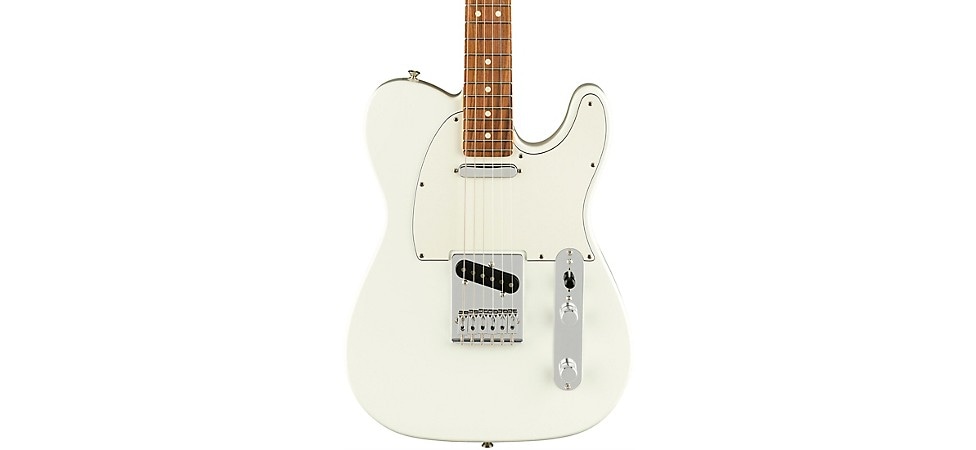
Pictured: Fender Player Telecaster
Fender Player Series Saturday Night Special Telecaster
The Fender Player Series Saturday Night Special Telecaster, a limited-edition spinoff from the ever-popular Player Series, boasts a distinctive Daytona Blue finish and houses a duo of Seymour Duncan Saturday Night Special pickups—previously available only as humbuckers. Wound hot and punchy, the bridge pickup is perfect for driving rhythms and searing solos, while the warmer, rounder neck pickup is ideal for country twang and bluesy leads.
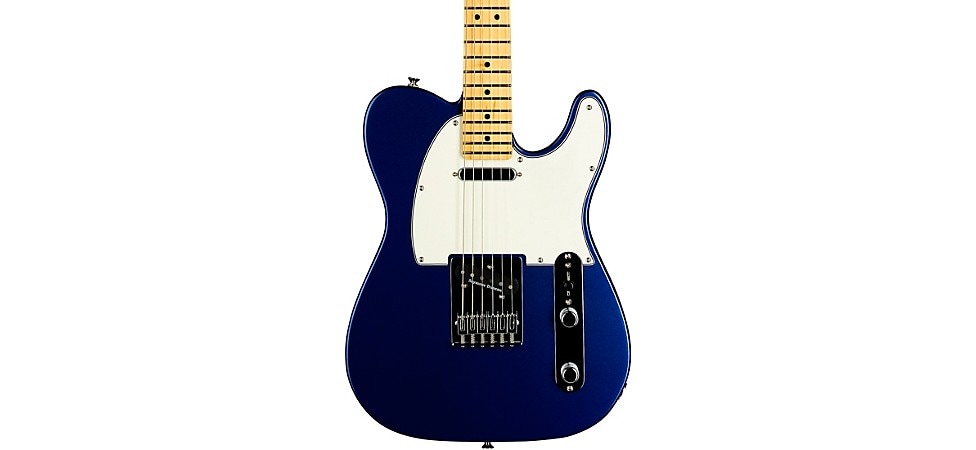
Pictured: Fender Player Series Saturday Night Special Telecaster
Fender Player Plus Telecaster
The Fender Player Plus series, as you might expect from the name, takes the Player series and ups the game. Both the pau ferro and maple fingerboard versions come in an array of stunning finishes, and feature modern neck profiles and fingerboard radii, along with the traditional Tele punchy single-coil twang.
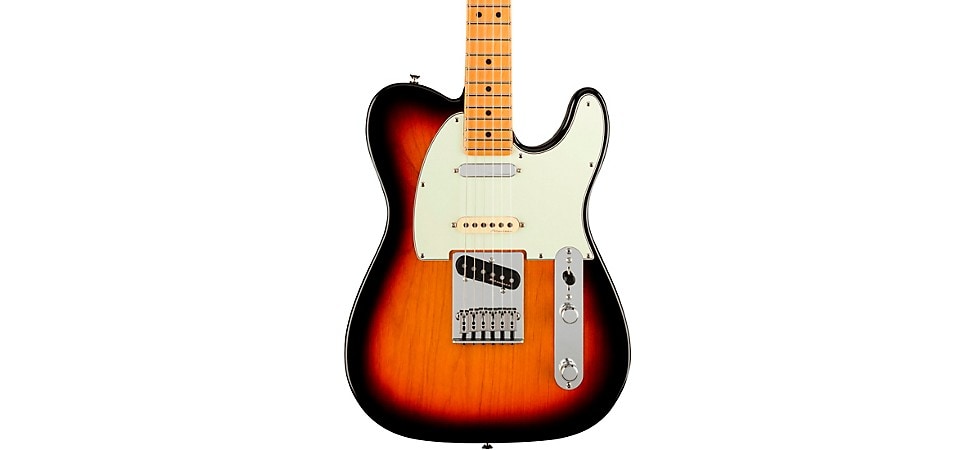
Pictured: Fender Player Plus Nashville Telecaster
Also available in the Player Plus series is the Fender Player Plus Nashville Telecaster. With the three-pickup setup so popular in Music City, this version offers added versatility with a Strat-style middle pickup added to the classic Tele tones.
Fender American Performer Telecasters
Proudly built in Corona, California, the Fender American Performer Telecaster models are the most-accessible made-in-USA Teles. The American Performer Telecaster is available as a standard dual single-coil or with Fender's unique Double Tap humbucker at the neck position, in either maple or rosewood fingerboard versions. All American Performer Tele models feature traditional brass barrel saddles for a touch of vintage tone.
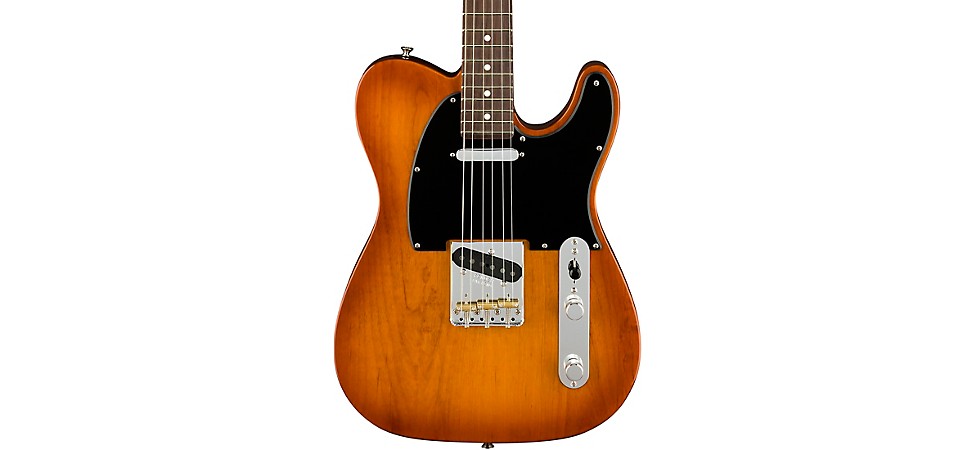
Pictured: Fender American Performer Telecaster
Fender American Professional II Telecasters
Whether you like a traditional Tele setup with maple or rosewood fingerboards or the '70s vibe of a Telecaster Deluxe with dual Wide-Range humbuckers, also available with maple or rosewood, the made-in-USA Fender American Professional series has the guitar for you.
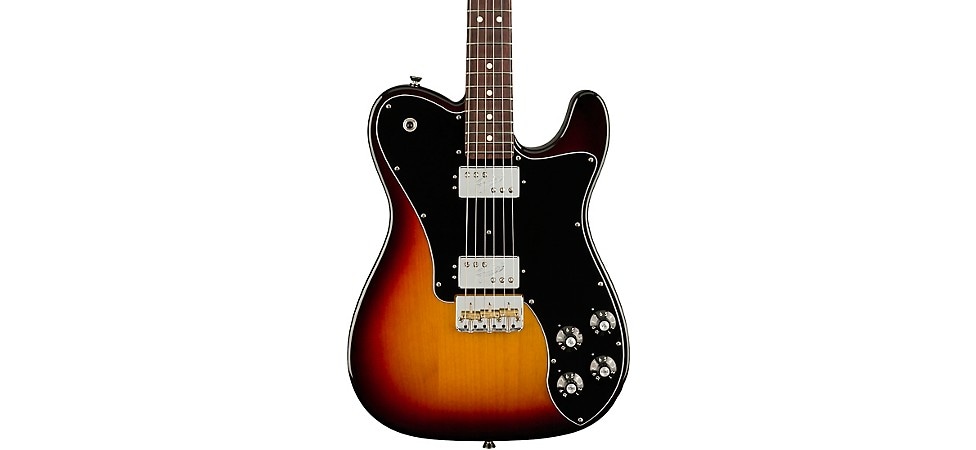
Pictured: Fender American Professional II Telecaster Deluxe
The American Professional II Telecasters include Custom-Shop-worthy features, like carefully rolled fingerboard edges, comfortably sculpted neck heel and V-Mod II pickups. The bridge boasts compensated brass barrel saddles and the ability to string either traditional thru-body or top-loaded. The American Professional Deluxe humbuckers have Fender's unique DoubleTap feature for immense sonic flexibility. Whichever one you choose, once you pick it up, you'll have trouble putting it down.
Fender American Ultra Telecaster
The flagship of Fender's USA production guitars has got to be the Fender American Ultra series. The Fender American Ultra Telecaster features Fender Vintage Ultra Noiseless pickups, an S1 switch for series or parallel pickup voicing, a compound-radius, rolled-edge maple or rosewood fingerboard, a fast, modern thin D neck profile, sculpted neck heel and a six steel-block-saddle bridge. Check this article for Isaiah Sharkey’s take on this guitar (plus the rest of the American Ultra series).
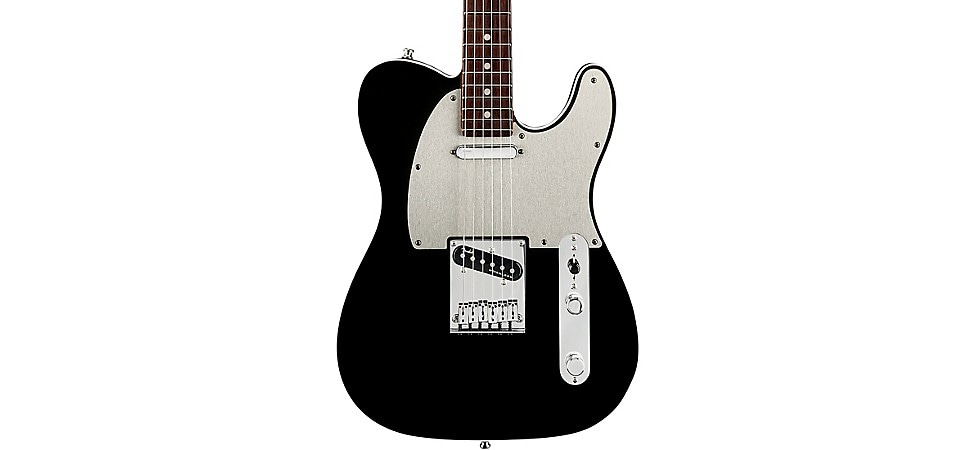
Pictured: Fender American Ultra Telecaster
If you still want something a little more distinctive, this limited-edition Fender American Ultra Tele with ebony fingerboard has a subtly gorgeous Umbra Burst finish that really stands out in a crowd of pickers.
Telecaster Artist Models
From its very beginnings, Fender has worked closely with a wide range of players—some well known, some less so—to make design tweaks and to personalize an artist's instrument to better suit their playing style. In some cases, players have made their own mods, then gone to Fender to have "official" versions built with those personal features. This tradition has led to a strong legacy of Artist Signature guitars, including some Telecasters that have gone on the become icons in their own right.
Christone "Kingfish" Ingram Fender Telecaster Deluxe
Mississippi's own Christone "Kingfish" Ingram took the blues world by storm as a teenage wunderkind. His signature Telecaster Deluxe boasts a pair of custom humbuckers, stamped with a "K" crown logo and wound for gritty, overdriven tones, along with an Adjust-o-Matic bridge and stopbar tailpiece for accuracy and sustain. The headstock bears Ingram's signature and the shimmering "Mississippi Night" finish brings to mind a wintry sky somewhere over Highway 61.
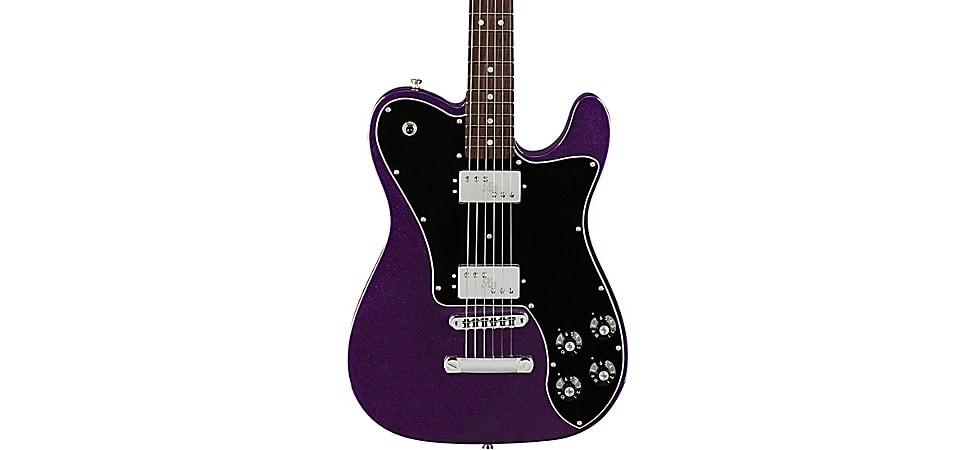
Pictured: Fender Kingfish Telecaster Deluxe
Brent Mason Fender Telecaster
Few guitarists have shown the versatility and sheer chops of Nashville session legend Brent Mason. Like its creator, the Brent Mason Signature Telecaster is at home with a unique blend of country, rock, jazz and more. With its three-pickup configuration—stacked Tele bridge, stacked Fat Strat middle and mini-humbucker neck—in the lightweight chambered ash body, it offers a near-infinite tonal palette, suitable for swinging bebop lines, down-home country shred and screaming rock leads. The Glaser Bender system enables effortless pedal steel-style licks with a slight tug on the strap. Whether you're chicken pickin' or grooving fingerstyle jazz, you'll feel right at home with this one.
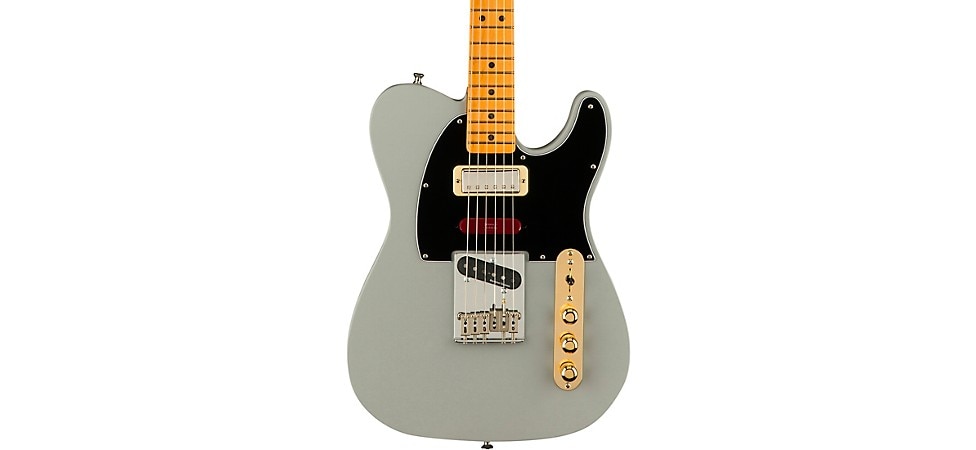
Pictured: Brent Mason Fender Telecaster
Jason Isbell Fender Telecaster
Alt-country's Jason Isbell's signature Tele is as iconic as the star himself. Loaded with custom Tim Shaw-designed humbuckers for a tone that finds a midpoint between rock raw and mellow, this double-bound alder-bodied Telecaster has a distressed sunburst finish suitable to the down-home, road-warrior vibe of Isbell and his band, the 400 Unit. The comfortable, '60s-style C-profile neck is topped with a vintage 7.25"-radius rosewood fingerboard. With a version of Isbell's familiar anchor tattoo engraved into the bridge plate, which carries classic three-barrel brass saddles, the Jason Isbell Signature Telecaster is a wonderful blend of vintage and modern.
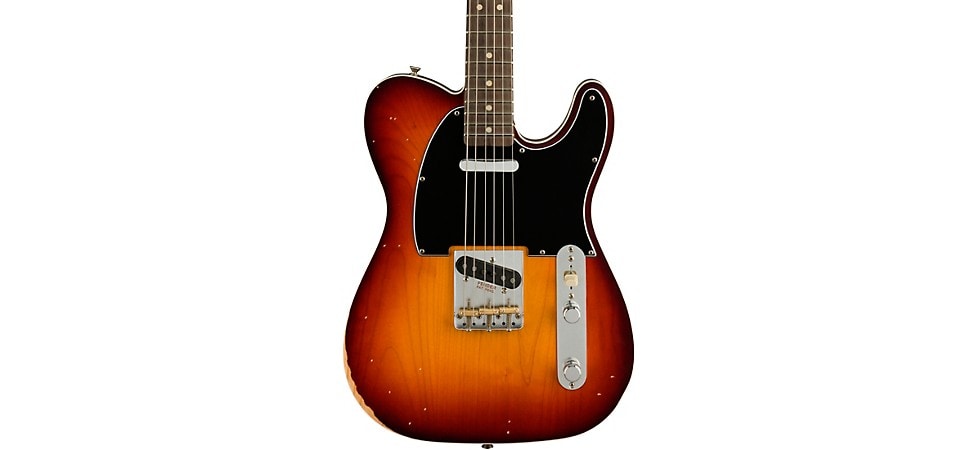
Pictured: Jason Isbell Fender Telecaster
J Mascis Fender Telecaster
As mentioned above, the Telecaster's versatility across musical styles is second to none, gracing everything from mellow jazz to the hardest rock. There's probably no player who more exemplifies the latter than J Mascis, whose work, both with Dinosaur Jr. and his solo work, has thrived on starting from a the basic platform of a Tele and turning it into a massive rock riff machine. Mascis' signature Telecaster starts with replicating the 1958 top-loading Telecaster he's used for lead work throughout his career, and adds custom-wound signature pickups that can carry the weight of getting heavy. Aesthetically, the blue sparkle finish and chromed pickguard add a unique visual touch and help make the guitar as unique as the player.
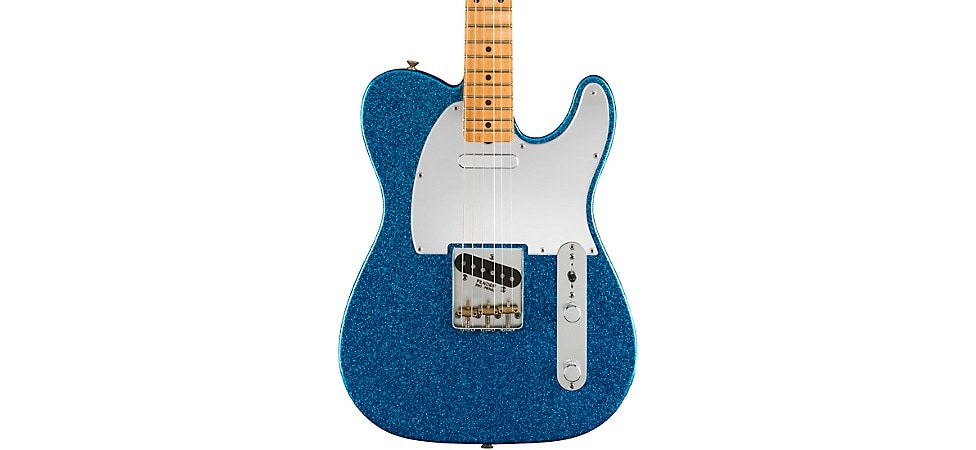
Pictured: J Mascis Fender Telecaster
Jim Root Fender Telecaster
Speaking of heavy guitar on a Telecaster, we have to make mention of the Jim Root Artist Series Telecaster. The legendary Slipknot and Stone Sour guitarist is renowned for his tonal impact, and this Tele is loaded with active EMG pickups to ensure that the guitar's output is always punchy, whether you're dialed back for crystal clear, or cranked for full-on raging tone. The use of a mahogany body, rather than the Tele's normal alder or ash, adds warmth that balances the extended high-frequency response of the active pickups. If heavy is what you're after, this may be the guitar you've been seeking.
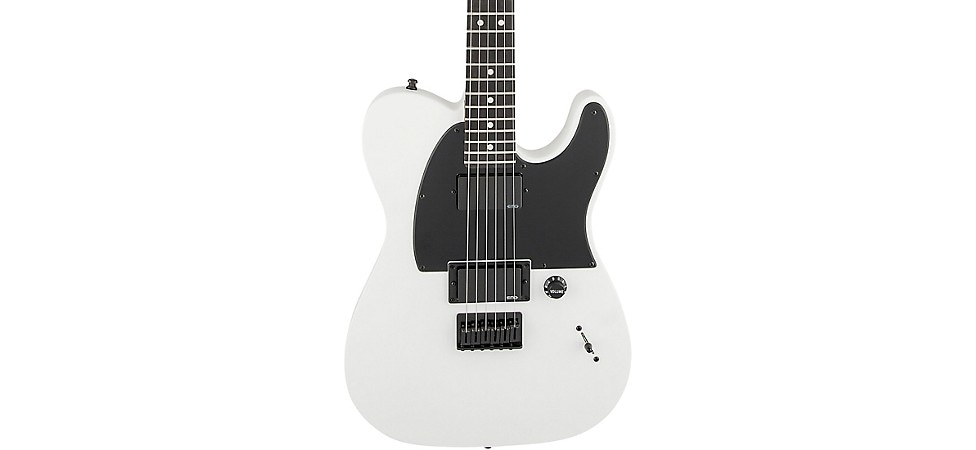
Pictured: Jim Root Fender Telecaster
Chrissie Hynde Fender Telecaster
When The Pretenders broke out as part of the 1970s "New Wave," singer/guitarist/songwriter Chrissie Hynde was a revelation. Chrissie's signature Tele is based on her treasured 1965 Telecaster, with a chromed pickguard for a touch of flash and custom-wound Chrissie Hynde single-coil pickups for her signature, slashing rhythm sound. The lightly aged hardware gives it the well-traveled vibe that tracks with Hynde's reputation as a tireless touring force.
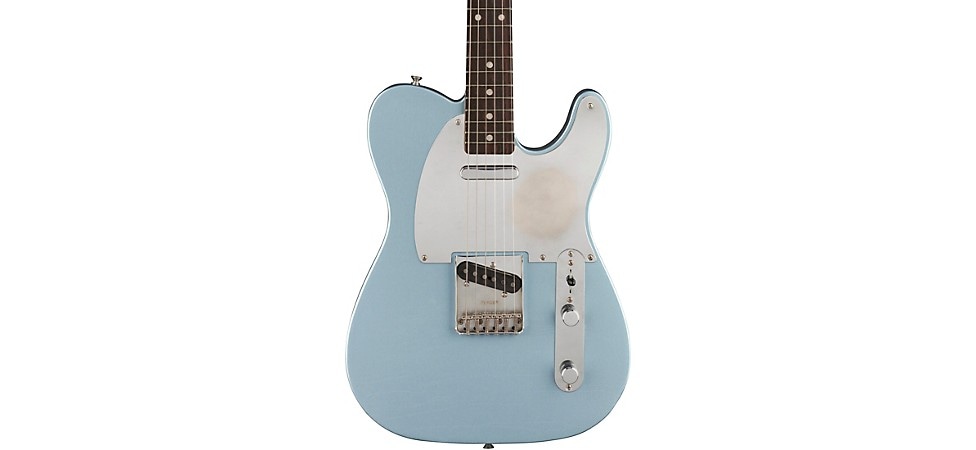
Pictured: Chrissie Hynde Fender Telecaster
Jimmy Page Fender Telecasters
We've touched on the history of the iconic inspiration for all three Jimmy Page Telecaster guitars earlier in this article, from its early days with Jeff Beck to its aesthetic evolution in the hands of Page, so we won't further rehash that here. Suffice it to say, there are few players and few guitars that are deserving of multiple iterations, and this particular instrument is probably foremost among them.
Created with input from the player himself, the Jimmy Page Mirror Telecaster replicates the original white blonde 1959 top-loader Tele that Page played with The Yardbirds and on early Led Zeppelin recordings. It features a two-piece ash body and custom-wound Jimmy Page 1959 Telecaster pickups, along with the period-correct, slim D-profile neck and 21-fret rosewood slab fingerboard. The guitar, graced with Page's signature on the headstock and neckplate, comes with a historically accurate tweed case, along with a unique set of "case candy" items—a set of mirrors you can use to decorate the guitar body as you wish, a coil-style instrument cable, "stained-glass" strap and a certificate of authenticity.
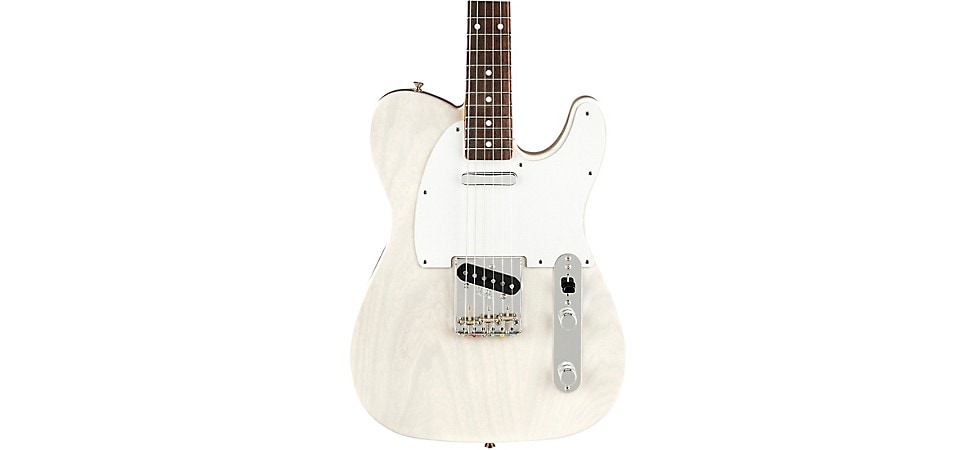
Pictured: Jimmy Page Fender Mirror Telecaster
The final evolution of this storied instrument was the removal of the mirrors, stripping of the finish and the creation of one of the most easily recognizable graphics ever put on a guitar—a hand-painted dragon. As you'd expect, since they are both descended from the same instrument Jeff Beck gave to Page, the specs are the same, other than the finish. In this case (vintage-style black hardshell, if you were wondering), the included case candy includes a "Whole Lotta Tele" strap.
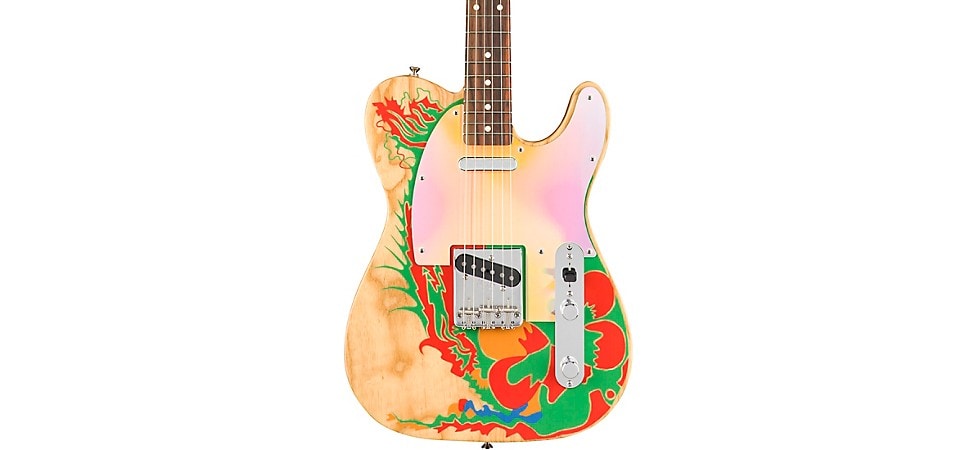
Pictured: Jimmy Page Fender "Dragon" Telecaster
Finally, for the truly serious Jimmy Page fan (or lover of fine history guitars), the Custom Shop version of the Jimmy Page Telecaster is an immaculate recreation of the 1959 top-loading Tele that started this all off. Crafted with the care, precision and dedication of Fender's Custom Shop builders, this is the ultimate Page Tele, taken back to its roots. The build is of carefully selected ash, with handwound Page single-coil pickups and all period-correct hardware. It also includes a vintage-style tweed case, the mirror application kit, the coil cord, "stained-glass" strap and the treasured Fender Custom Shop Certificate of Authenticity.
Raphael Saadiq Fender Telecaster
Designed in concert with the Grammy Award-winning producer, the Fender Raphael Saadiq Signature Telecaster combines vintage and modern features, along with a unique finish on the bound ash body and a custom pickguard that match the visual style and flair of the artist. Featuring a slim '59 C neck profile and a modern 9.5" radius rosewood fingerboard that boasts vintage-tall frets on the custom-bound neck, along with custom Raphael Saadiq single-coil pickups, the tone can go from classic Tele vintage to modern attitude, matching the musical range of the artist.
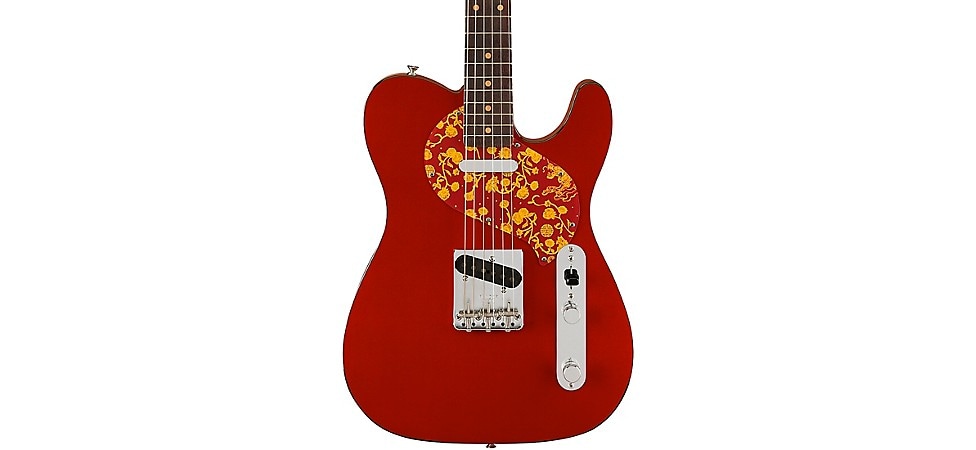
Pictured: Raphael Saadiq Limited-Edition Fender Telecaster
The Fender Custom Shop Telecaster
Maybe you're looking for one of the handmade, limited-edition versions. Maybe there's a specific artist signature Tele that you want custom built. Or maybe, one of the Fender Custom Shop's Master Builders has created a one-off work of art that you've fallen deeply in love with (that's okay, we understand). Whatever it is, a Fender Custom Shop Telecaster is a guitar you will treasure and play for the rest of your life.
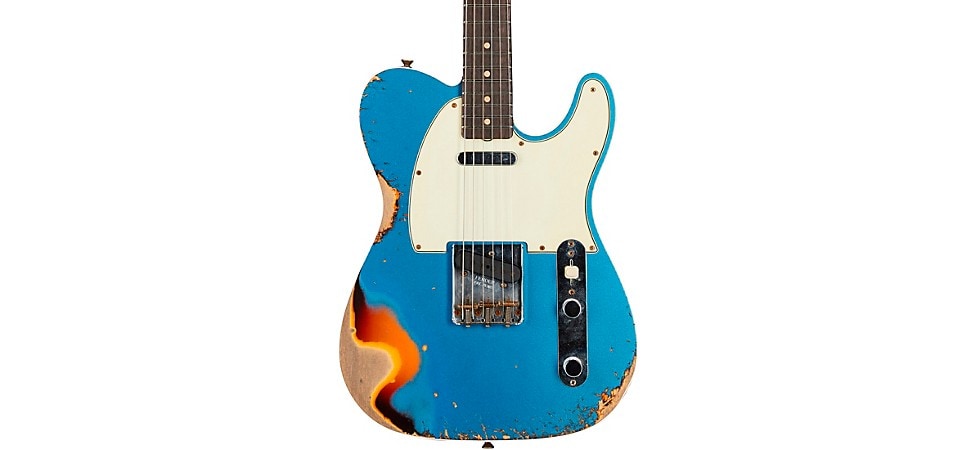
Why is that? Since their founding in 1987, the Fender Custom Shop has maintained a goal of advancing the art of luthiery, while keeping a deep respect for the traditions of the past. Just to be chosen as one of the Custom Shop builders would be accolade enough for most. It means you've achieved a level of quality, precision and accuracy in your work that is beyond merely worthy. To advance to the level of Master Builder adds on the inspiration and vision of a true artist. Any of the Telecaster models from the Custom Shop will play and sound like a dream, becoming an extension of your body and even, dare we suggest, of your musical soul.
So if you've got a dream Tele that you'd like to make reality, talk with us about Custom Shop instruments, and we can help make it happen.
Everybody Needs a Tele
Considering that this iconic guitar has several books at least ten times this long tracing its history and evolution, we've barely had room to touch on the deep impact that the Telecaster has had, and continues to have, on the development of the electric guitar. It's not ever enough space to cover all the different Tele models that are available today. And speaking of Tele models, the best way to find out what's right for you is to stop by your local Guitar Center, speak with one of our knowledgeable Associates and play a few to find the exactly correct match. Or, you can speak with the equally knowledgeable Associates at our Call Center to track down your Telecaster. Of course, you can browse to your heart's content on our website, and see everything that's available, all in the comfort of your home (or office—it's okay, we won't tell your boss). Whatever way you choose to shop, a Telecaster is a guitar that belongs in everybody's collection. It's that simple.
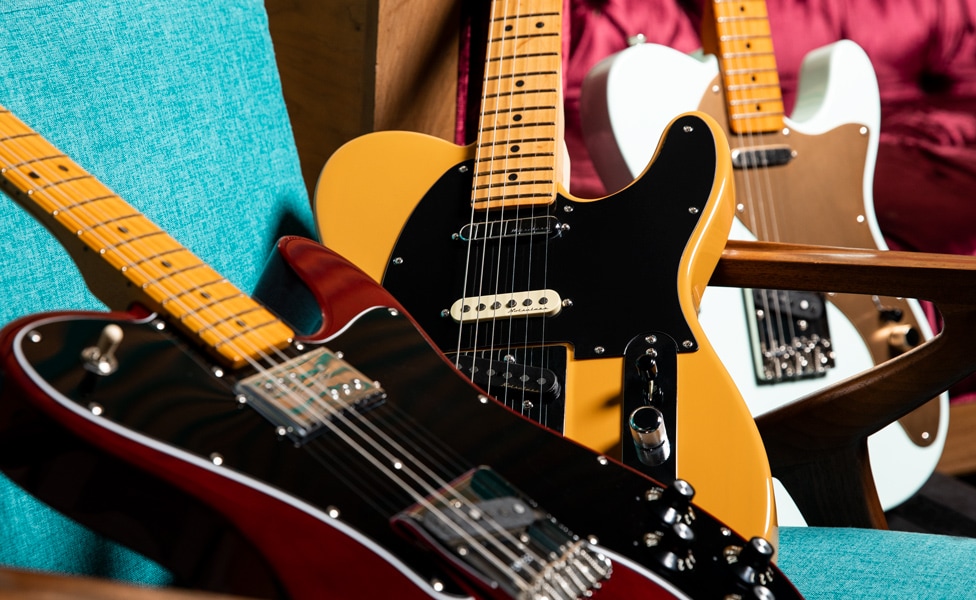
Legends of the Telecaster
One reason so many players love their Tele is that the unique sound and feel of the instrument seems more nuanced and accurate in capturing a player's individual voice. Some feel that they play better on a Telecaster because the instrument leaves you, and your playing, no place to hide. Looking at the range of players over the years, it's obvious that one thing Tele players have in common is a serious commitment to making the most of what they've got.
The Players
Musically, the Telecaster has crossed genres with alacrity, though in its earliest years it was most associated with the country and Western swing players who had started dropping by Leo Fender's radio repair shop in Fullerton, CA in the mid-1940s. But the guitar, along with Fender's amps, were fairly quickly adopted by guitarists in the burgeoning rock and roll scene, as well as electric blues players, R&B and soul players and jazz players, all of whom were discovering just how versatile a guitar as simple as the Telecaster could be. Since there have been so many notable Tele players over the years, what we're presenting here is just a sampling, broken down by genre and spanning from the very beginning of the Telecaster's existence in 1950 to the present day. While some of these players, like BB King, are better known with their other guitars, at one point or another, they've all been Telenauts. For example, Jimi Hendrix, who's almost universally identified with the Fender Stratocaster, played a Tele borrowed from Noel Redding on the studio recordings of "Purple Haze" and "Fire," though rumor also cites "The Wind Cries Mary" and "Hey Joe," for some parts.
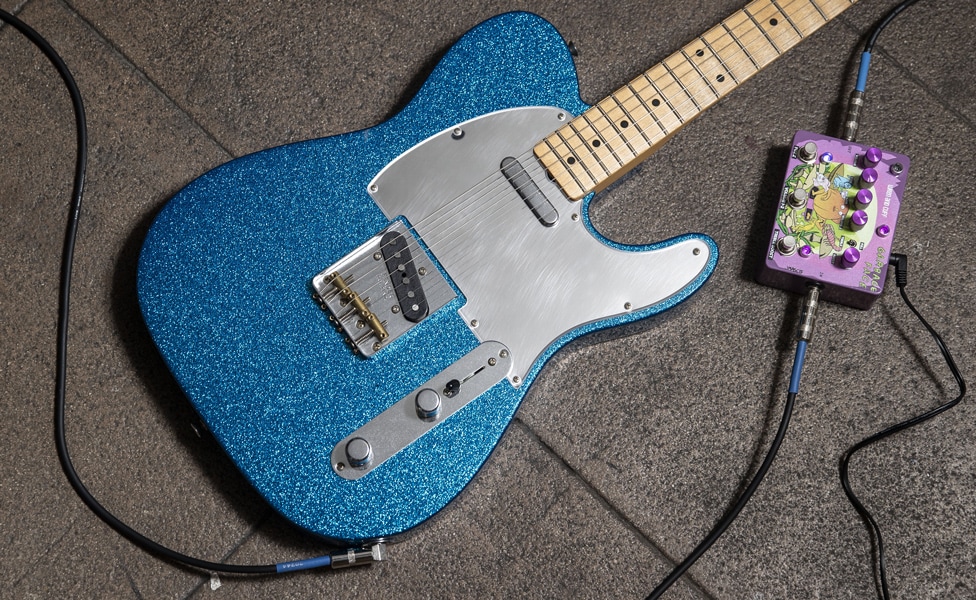
Country: Jimmy Bryant, Buck Owens, Don Rich, Waylon Jennings, Merle Haggard, Albert Lee, Clarence White, Brent Mason, Vince Gill, Pete Anderson, Marty Stuart, Will Ray, Jerry Donahue, Redd Volkaert, Brad Paisley, Jason Isbell
Blues, Soul and R&B: Muddy Waters, BB King, Clarence "Gatemouth" Brown, Albert Collins, Mike Bloomfield, Steve Cropper, Cornell Dupree,
Jazz: Ed Bickert, Joe Pass, Tommy Tedesco, Robben Ford, Mike Stern, Bill Frisell, Julian Lage,
Rock/Pop: Paul Burlison, James Burton, George Harrison, Keith Richards, Jeff Beck, Pete Townsend, Jimmy Page, Joe Strummer, Syd Barrett, Bruce Springsteen, Chrissie Hynde, Andy Summers, Mike Campbell, Johnny Marr, Sheryl Crow, Richie Kotzen, Tom Morello, J Mascis, Matt Bellamy, John 5, Jim Root
And, finally, a handful of players who defy easy pigeonholing when it comes to genre: Roy Buchanan, Danny Gatton, Jim Campilongo, Arlen Roth and Greg Koch.
We've really only scratched the surface here, and you can have a lot of fun doing some of your own research and discovering some of the incredible Tele players from today and from decades past. But next, let's take a look at some of the defining recordings that feature a Telecaster, front and center.
Iconic Tele Recordings
Following is a collection of touchstone moments of Tele tone over the years. Feel free to use your favorite streaming service to check them out and fully appreciate the range and versatility of the original "canoe paddle."
Jimmy Bryant & Speedy West—"Arkansas Traveler"—Jimmy Bryant, one of the first endorsers of the Telecaster burns up this classic fiddle tune, with the able assistance of Fender steel guitar endorser, Speedy West.
Johnny Burnette and the Rock 'n' Roll Trio—"Rockabilly Boogie" and "Train Kept A-Rollin'"—Paul Burlison in his work with the Burnette Brothers was one of the definers of early rock and roll/rockabilly guitar.
Dale Hawkins—"Suzy Q"—A 16-year-old James Burton on the record that started his career.
Buck Owens—"Act Naturally"—A Tele-two-fer, with both Buck and long-time sideman, Don Rich doubling up the Telecaster goodness.
Muddy Waters—"Same Thing"—Muddy's tone wouldn't have had that snaky, cutting quality without that Tele. Check the studio version from the Muddy Waters—Folk Singer album.
The Yardbirds—"Train Kept A-Rollin'"—Wait! We've been here before, haven't we? Same song, but here it's Jimmy Page revving up the engine, on a 1959 Tele that was gifted to him by Jeff Beck when Page joined the band.
Albert Collins—"Frosty"—One of the "Iceman's" signature tunes, and a fine addition to the history of hot Texas blues instrumentals.
Head, Hands & Feet—"Country Boy"—Albert Lee's original recording of the song that's pretty much become his signature over the years.
Cornell Dupree—"Okie Dokie Stomp"—tearing it up covering Clarence "Gatemouth" Brown's jumping instrumental. From his album, Teasin'.
Led Zeppelin—"Stairway to Heaven"—We just had to throw this in here because it's the song that proved to many doubters that the Telecaster wasn't just for country music. And we're back to that same '59 Tele that Page played on "Train Kept A-Rollin'" with The Yardbirds.
Roy Buchanan—"Sweet Dreams"—Buchanan combines sweet melodic Tele with some ferocious runs that showcase his dexterity.
Paul Desmond Quartet—"Here's That Rainy Day"—Canadian jazz guitarist Ed Bickert is featured, showing how fat and smooth a Tele tone can get.
The Clash—"London Calling"—Joe Strummer's Tele on the song that brought the band into the mainstream.
The Police—"Driven to Tears"— Andy Summers playing his Telecaster Custom.
Bruce Springsteen—"Born to Run"—Springsteen shows his beloved old Esquire who's the boss, not just on this song, but all over the album that made him a superstar.
Danny Gatton—"Sun Medley"—Gatton provides sheer fireworks on this rockabilly workout. Some guitarists have been chasing these licks for decades.
Robben Ford—"Milam Palmo"— Ford featuring a '52 Tele on this one from his album, Pure.
Jeff Buckley—"Hallelujah"—A beautiful version of just how ethereal a Tele can be.
Slipknot—"Psychosocial"—The metal side of the Telecaster, from Jim Root.
Muse—"Stockholm Syndrome"—Matt Bellamy lays it down. While we don't know for sure, this may be the same Tele once owned by Jeff Buckley.
Radiohead—"Paranoid Android"—Sure, lots of people just plug it straight into an amp, but one of the strong points of a Tele has always been how well its unique voice works with pedal and processing.
John 5—"Six Hundred and Sixty Six Pickers in Hell Ca"—Country Metal is a thing. Who knew?
Jason Isbell and the 400 Unit—"Be Afraid"—Isbell and his band turn out melodic, memorable riffs that still rock, and his '65 Tele is featured on the verses.

